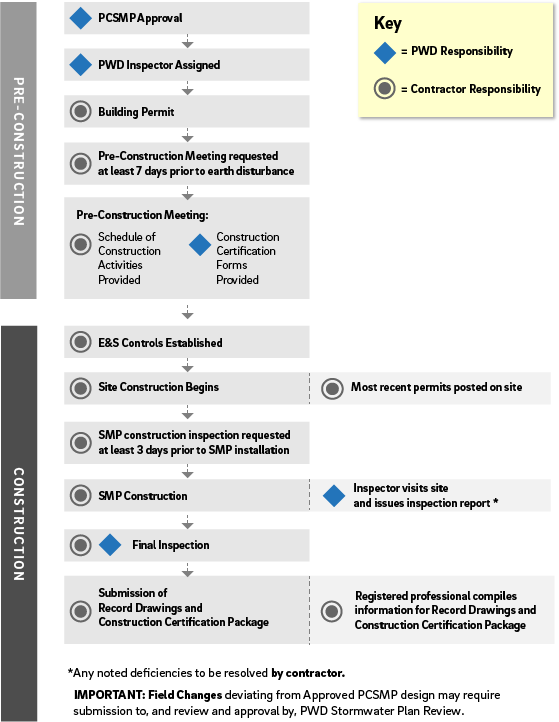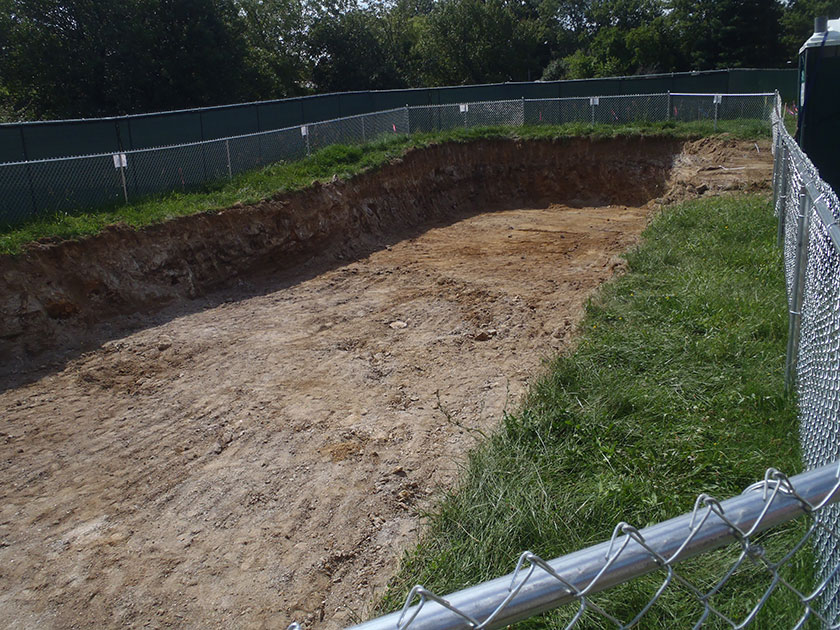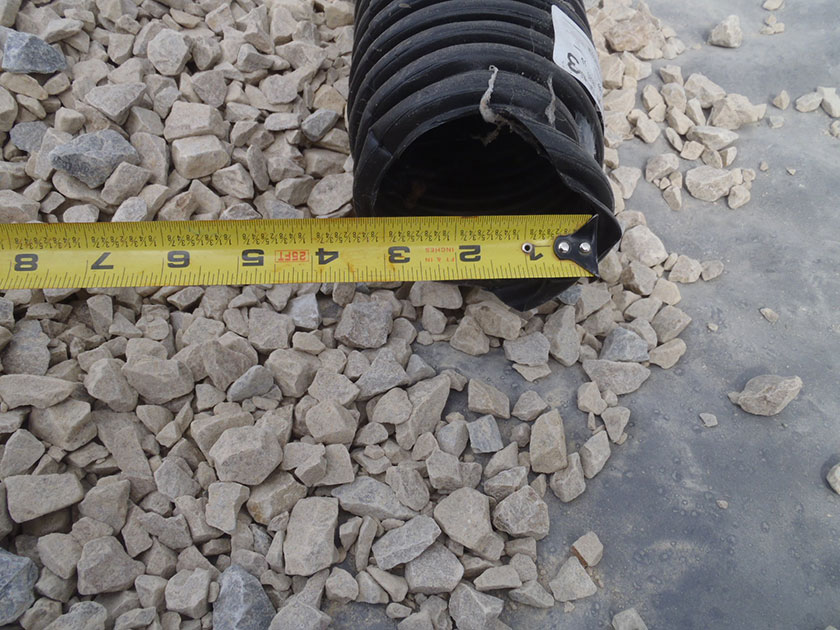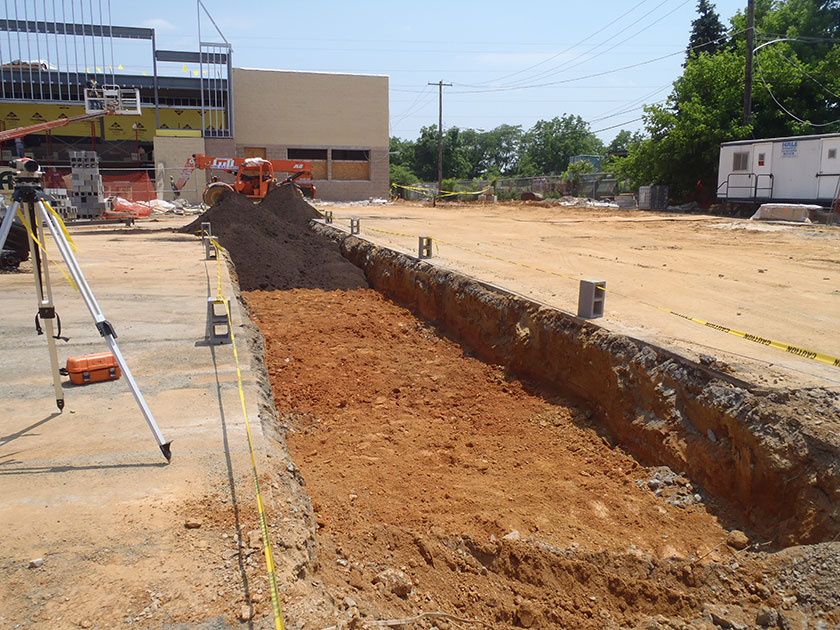-
5.0 Introduction
Site development and stormwater management practice (SMP) construction require careful execution and inspection to ensure that SMP elements function properly and that impacts of construction activities on the surrounding environment are minimized. Chapter 5, Construction Guidance, provides guidance for developers, engineers, and contractors on construction-related topics, including construction inspections (Section 5.1), commonly encountered construction issues (Section 5.2), and construction documentation (Section 5.3). Specific construction guidelines for each SMP are provided in Chapter 4.
The Philadelphia Water Department (PWD) provides construction oversight during SMP installation in order to verify that correct installation practices are used and to focus on the protection of infiltration areas from compaction by construction equipment. PWD construction oversight includes inspection reporting and enforcement activities.
Section 5.1 explains the purposes of construction inspections and provides guidance on the construction inspection process including PWD contact information, assignment of a PWD Stormwater Inspector (PWD Inspector), preconstruction meeting, documentation requirements during the construction process, final inspections, and post-construction submission requirements.
Section 5.2 includes common construction issues associated with Erosion and Sediment Control (E&S) and SMP installation in order to help minimize or avoid them. Section 5.2.1 describes common E&S-related construction issues including protection of City-owned inlets and other E&S-related construction issues. Section 5.2.2 describes common SMP-related construction issues including protection of infiltration areas, use of clean stone, pipe loading, and inspection and documentation. PWD requires contractors to submit construction documentation at the close of the project to ensure that the SMP and its elements were constructed in general accordance with the Approved Post‑Construction Stormwater Management Plan (PCSMP). Record Drawing(s) are required from the applicant for SMP verification and represent a key component of PWD’s compliance reporting.
-
5.1 Construction Inspection
Effective construction inspection addresses both Erosion and Sediment Control (E&S) and stormwater management practice (SMP) construction. To supplement construction oversight provided by the property owner and the designer, the Philadelphia Water Department (PWD) inspects both E&S measures and SMP installation to verify that the site is maintained properly and correct installation practices are used. PWD staff inspects the site at several stages of the construction process, and inspections may occur both on a scheduled and a complaint-driven basis. An overview of the construction inspection process is shown in Figure 5.1‑1.
Figure 5.1‑1: Overview of Construction Inspection Process

PWD’s inspections serve a number of purposes. For instance, PWD must verify and document the installation of SMP elements prior to backfill in order to prevent costly repairs and/or re-excavation that may be needed either during or after construction. PWD’s inspections are also critical to ensure the long-term performance of SMPs and minimize future enforcement scenarios stemming from improper installation practices. PWD Inspectors verify that infiltration areas are correctly sized, shielded from sediment loading prior to site stabilization, and protected from compaction.
PWD Inspectors are authorized to access sites under authority provided by Philadelphia Code (§14-306(1)(a)). PWD Inspectors will inspect the project site throughout construction.
5.1.1 Coordinating Inspections with Other PWD Units
Different PWD units may inspect multiple parts of construction projects (E&S, SMP installation, sewer connections, pumping, private cost construction, etc.). The following divisions can be contacted based on project needs:
Table 5.1‑1: PWD Unit Contact Information
Unit Name Phone Number Inspection Type Stormwater Inspections 215-685-6387 E&S Measures
SMP ConstructionWater Transport Records 215-685-6270 Water and Sewer Connections Construction Division 215-685-6345 Private Cost Construction Industrial Waste 215-685-6085 Pumping of Stormwater Stormwater Inspections must be contacted for all site development and SMP construction projects. PWD Water Transport Records (WTR) must be contacted for any inspections related to water and/or sewer connections. Written approval from WTR following the completion of certain sewer connection requirements will be required for project close-out. A permit is required for sewer tie-ins six inches in diameter or larger. Direct pumping of stormwater to a storm inlet or manhole is prohibited. The PWD Industrial Waste Unit should be contacted for all pumping needs, including permits. If the project includes the construction of public infrastructure using private money (Private Cost Project), the contractor must contact the PWD Construction Division to arrange an inspection at least seven days in advance of work. The designer is referred to Section 2.5 for additional information on the role of these units.
5.1.2 Preconstruction Processes
Assignment of PWD Inspector
Following Post‑Construction Stormwater Management Plan (PCSMP) approval, project contacts supplied by the applicant will receive an email from Stormwater Inspections that assigns a PWD Inspector to the project. This PWD Inspector will be the main contact for E&S and SMP inspections. PWD will only email the project contacts that have been provided by the applicant at the time of PCSMP Approval. As such, the email may be sent to the design engineer, but not the contractor, particularly if a contractor had not been selected at the time of PCSMP Review Phase submission. It is the responsibility of the applicant to ensure that all necessary parties have been notified that an inspector has been assigned. If unaware of the specific PWD Inspector for the project, the applicant should contact Stormwater Inspections.
Once the PCSMP Approval Letter is received, the applicant can obtain a Building Permit for the project from the City of Philadelphia Department of Licenses and Inspections (L&I), pending the receipt of other required approvals. PWD Stormwater Plan Review or Stormwater Billing and Incentives must be notified of any changes to the Approved E&S and PCSMP, layout, and/or materials prior to installation. Field changes may require new PWD and Pennsylvania Department of Environmental Protection (PA DEP) approvals, in addition to approval by the design engineer. The designer is referred to Section 2.3.1, PCSMP Review Phase, for more information on field changes.
Preconstruction Meeting
After a Building Permit and a PA DEP National Pollutant Discharge Elimination System (NPDES) Permit (if applicable) have been obtained, but prior to the start of construction activities, a preconstruction meeting must be held with the contractor, design engineer, an owner’s representative, and the PWD Inspector for any projects that have received a PCSMP Approval. PWD may also require an E&S-only preconstruction meeting for certain projects in the Development Exemption or Demolition Review Paths. The PWD Inspector must be provided with at least seven days notification to schedule this meeting.
At the preconstruction meeting, the PWD Inspector will provide the contractor with the Construction Certification Forms (Appendix J) that were prepared for each SMP by the design engineer during the PCSMP Review Phase. The contractor must provide the PWD Inspector with an estimated schedule for the placement of geotextile, stone, storage media, piping, soil, etc.
5.1.3 Construction Processes
Once construction begins, the contractor must ensure that copies of the Approved PCSMP, E&S Plan, and NPDES Permit (if applicable) are available on-site at all times. The most recently PWD-approved versions of these plans must be used for SMP construction.
The contractor must provide at least three days’ notice to the assigned PWD Inspector prior to the installation of any SMP elements. This is especially critical for subsurface system elements, as without proper inspection prior to backfill or closure of any SMP elements, the PWD Inspector may request re-excavation in order to verify correct installation.
Throughout construction observation, the PWD Inspector will regularly send out (via email) inspection reports that detail any deficiencies or issues observed related to SMP construction or E&S measures. PWD expects the contractor to respond to any issues in a timely fashion, and, depending on the type of issue, may provide a timeframe for the contractor to remediate the issue.
In instances where major E&S issues are observed, the PWD Inspector will issue a notice of violation to fix any E&S concerns with a re-inspection date listed. If these concerns are not addressed by the date of re-inspection, PWD will pursue a Stop Work Order that will remain in place until the project is brought back into compliance.
During any stage of work, if the PWD Inspector determines that SMPs are not being installed in accordance with the most recently Approved PCSMP, or that adequate E&S practices are not being implemented on-site, and the contractor is not responsive to such notice by PWD, the site may be subject to a Stop Work Order and/or other enforcement measures. This also applies to projects found to be disturbing earth without the appropriate approvals or inadequate E&S measures.
5.1.4 Final Inspection
A final inspection will be conducted by the PWD Inspector to confirm the constructed conditions of the site and general accordance with the Approved PCSMP prior to the issuance of the Certificate of Occupancy or equivalent. PWD may request that L&I withhold the Certificate of Occupancy for any project with outstanding issues until these issues are adequately addressed. The contractor must be present on-site for completion of the final inspection. A Post‑Construction Stormwater Management (PCSM) Final Inspection Report will be issued identifying the SMPs found to be complete as well as any deficiencies identified during the inspection. All deficiencies identified during PWD’s final inspection and report must be addressed prior to any re-inspections.
Upon completion of PWD’s final inspection process, an updated PCSM Final Inspection Report will be issued indicating that all components of the SMP construction are complete and the as-built conditions of the site are in general accordance with the Approved PCSMP. Final inspection reporting and its conclusions are preliminary, and the final determination of site compliance will be based on the Record Drawing and Construction Certification Package (CCP) for the site. The Record Drawing and CCP should be provided at the time of the final inspection, if possible. Final inspection is required for issuance of a Record Drawing compliant letter for a project to be eligible for stormwater credit (Section 6.3).
5.1.5 Post‑Construction Submissions
If not submitted during the final inspection, the project’s Record Drawing and CCP must be submitted to PWD for review following the final inspection. Submitted Record Drawing(s) must also incorporate any constructed variations/discrepancies documented in the PCSM Final Inspection Report.
For PA DEP Notice of Termination (NOT) for NPDES Permits, PWD is required to sign-off on completion of the project prior to PA DEP issuance of the NOT. PWD will not sign-off without a PCSM Final Inspection Report deemed complete, a complete CCP, and compliant Record Drawing(s).
-
5.2 Common Construction Issues
An understanding of common construction issues associated with Erosion and Sediment Control (E&S) measures and stormwater management practices (SMPs) is an important component of effective construction inspections and can help to minimize or avoid these issues. Avoiding these issues streamlines regulatory approval, minimizes negative impacts to the surrounding environment, promotes long-term SMP function, and reduces the cost and duration of construction activities.
5.2.1 Erosion and Sediment-Related Construction Issues
Proper E&S measures are required to keep sediment and pollutants out of existing and proposed sewer systems and, ultimately, Philadelphia’s waterways. The goals of E&S measures are to minimize the amount of erosion that takes place and to keep all sediment accumulation within the earth disturbance boundary. E&S measures are also critical to the protection of existing on-site infrastructure and to reducing the risk of downstream impacts like sediment blockages. Approved E&S measures must be installed and inspected prior to the start of any earth disturbance activities. These E&S measures must be maintained and functional throughout the duration of construction, until the site has been stabilized.
Protection of City-Owned Inlets
Any city-owned inlets that receive stormwater runoff from the construction site must be protected. Contractors need to pay special attention to inlets located at the lowest points, as these will likely receive the most sediment and need to be maintained the most frequently. City-owned inlet protection should not be the primary means of E&S, but an important safeguard to supplement keeping sediment on-site through continuous E&S maintenance, including prevention of sediment tracking off-site.
Additional Erosion and Sediment Issues
Silt fencing must be properly trenched into the ground and backfilled to properly control sediment run-off from any disturbed areas. E&S controls must also be placed around SMP elements to prevent sediment loading from any surrounding unstabilized, disturbed areas. Also, in order to prevent SMP clogging and off-site impacts, all SMP inlets and other on-site inlets must be protected for the full duration of construction activities and until the site has achieved final stabilization. Bioinfiltration/bioretention basins and subsurface infiltration basins may be used as sedimentation basins during construction. The contractor is referred to Section 4.1 and Section 4.4, respectively, for requirements for the use of these SMPs as temporary sediment basins.
5.2.2 Stormwater Management Practice-Related Construction Issues
Compaction or sedimentation within infiltration areas and the use of stone containing fines are among the most common construction issues that can affect the infiltration capacity, and thus the performance and suitability, of an SMP.
Protection of Infiltration Areas
Protection of infiltration areas is important because, with the exception of SMPs designed to function as disconnected impervious cover (DIC), infiltration SMPs are designed based on testing that is performed on undisturbed soils prior to installation. Compaction of these areas could change infiltration rates and cause the SMP to underperform, leading to the need for redesign and/or reconstruction of the SMP. For these reasons, soil compaction should be minimized, even in areas not proposed for infiltration SMPs, to the extent practicable. The best strategy to avoid compaction is to simply avoid equipment traffic within proposed infiltration areas, before, during, and after SMP construction. Where construction equipment traffic is necessary, timber matting or low pressure equipment must be used.
If compaction of infiltration areas is required due to site constraints, the contractor must scarify the ground surface to minimum depths of eight inches for minor compaction and 12 inches for major compaction within the infiltration footprint prior to SMP installation.
Requirements for Protecting Infiltration Areas
- Do not use heavy equipment such as excavators, loaders, or dump trucks within the infiltration area, before or after excavation.
- Establish heavy equipment exclusion zones so that infiltration areas are clearly protected.
- Install orange construction fence or silt fence around the exclusion zones.
- Keep equipment out of the infiltration area to the maximum extent possible.
- Consider equipment limitations and maneuverability during design to facilitate operation of equipment outside the infiltration area.
- Do not locate rock construction entrances on top of areas proposed for infiltration practices.

An example of infiltration area protection during construction in Philadelphia Use of Clean Stone
Clean-washed stone must be used where indicated by SMP designs. Clean-washed stone must not only be delivered to the site in a clean state, but also stored, moved, and installed in a manner that does not introduce fines. Failure to install appropriately clean stone could impact infiltration performance and require redesign and/or reconstruction. The PWD Inspector may test a sample of stone at any time it is suspected of not meeting required standards. Stone will be tested using the AASHTO T-11 wash loss test and must have less than 0.5% wash loss.
Pipe Loading
Sufficient temporary cover of piping must be provided during all stages of construction, and heavy loads on these pipes must be avoided. Heavy loads can cause separation or damage to the pipe system that, while not necessarily readily apparent, could lead to long-term functionality and maintenance concerns. Any stone placed on top of piping must be placed gently (i.e., not dumped) to avoid these issues.
Inspection and Documentation
The contractor must ensure that all subsurface SMP elements have been inspected by PWD and fully documented (survey data, photos, etc.) prior to backfilling these areas to prevent corrective actions that could include re-excavation to affirm correct installation practices.
-
5.3 Construction Documentation
It is important, both for the property owner and for the Philadelphia Water Department (PWD), to ensure that all stormwater management practices (SMPs) are constructed in strict accordance with the Approved Post‑Construction Stormwater Management Plan (PCSMP). Even small variations in the characteristics of an SMP (e.g., footprint area, elevations, layer thicknesses, pipe sizing) can have significant effects on the SMP’s ability to perform its designed stormwater management function. To verify that SMPs have been properly installed, a Construction Certification Package and Record Drawing(s) for all PCSMP components must be prepared and submitted to PWD at the conclusion of construction activities. The contractor must maintain copies of all books, records, and documents pertaining to PCSMP construction for a period of five years following completion of the contract.
5.3.1 Construction Certification Package
As previously discussed, the contractor must install all on-site SMPs, conveyance piping, structures, and any other feature associated with the stormwater management design in strict accordance with the Approved PCSMP. The Construction Certification Package provides PWD with documentation that SMPs have been properly installed. Stormwater Retrofits have different requirements for Construction Certification Packages. The applicant is referred to Section 2.3.4 for Stormwater Retrofit submission guidance.
Prior to Construction
SMP Construction Certification Forms are part of the Construction Certification Package. Prior to construction, an SMP Construction Certification Form must be prepared by the design engineer for each on-site SMP and provided to PWD for review as part of the PCSMP Review Phase (Section 2.3.1). A blank Construction Certification Package template, which houses the SMP Construction Certification Forms and instructions, can be found in Appendix J. Each Form must indicate the measurements that are most critical to the listed SMP’s ability to perform its designed function (e.g., elevations, outlet control sizes, surface areas, layer depths, etc.). It is recommended that the SMP Construction Certification Form(s) be included in the construction bid documents for the project to ensure that the selected contractor is aware of the requirement that the Forms be completed during construction. The project’s sequence of construction must identify all stages of SMP construction for which a registered professional must document the specific elevations and measurements found on the SMP Construction Certification Form(s). The applicant is referred to Section 5.3.2 for clarification on PWD Stormwater Plan Review’s definition of a “registered professional.” If a project field change necessitates a revision to any information on the submitted SMP Construction Certification Forms, they must be updated accordingly and submitted along with the PCSMP Field Change submission.
During Construction
During the preconstruction meeting, the PWD Inspector will provide copies of the Construction Certification Package, as prepared and customized by the engineer and found acceptable by PWD during the PCSMP Review Phase. In order to demonstrate that all SMPs are properly installed, a registered professional must complete the SMP Construction Certification Forms contained within the Construction Certification Package. Each measurement documented on the Forms must be dated and initialed by the registered professional who took, or whose designee took, the measurement. Once all of the required measurements have been appropriately documented, the registered professional must execute and date the Form. The contractor should not cover, backfill, or seal any SMP until the information required for the Record Drawing(s) and the Construction Certification Package has been acquired.
All elevations identified on the Forms must be documented as they are measured. These Forms must be on-site and available for PWD inspection at all times. Upon completion of construction, SMP Construction Certification Forms must be submitted to PWD as part of the Construction Certification Package, and the measurements documented on these Forms must be reflected on the Record Drawing(s), which are discussed in the next Section.
The Construction Certification Package provided to PWD must include electronic copies of receipts for materials that pertain to SMPs. The material receipts must clearly specify the types, qualities, and quantities of the materials purchased. The materials for which receipts are required may include, but are not limited to, the following:
- Stone,
- Geotextile fabric,
- Perforated pipes,
- Subsurface storage units,
- Bioinfiltration/bioretention media,
- Filter media,
- Porous pavement,
- Impervious liners,
- Precast concrete structures,
- Traps or hoods,
- Vegetation or plantings, and
- Proprietary stormwater management systems/devices/components.
The Construction Certification Package must also include electronic copies of photographs documenting all SMP installations. The photographs must clearly depict the installation of all components of the SMP. This may include, but is not limited to, photographs of the following:
- Basin excavation,
- Subgrade preparation,
- Fabric or liner placement,
- Stone placement,
- Filter media placement,
- Pipe placement,
- Pipe perforation,
- Subsurface vault installation,
- Pretreatment system installation,
- Inlet control installation,
- Outlet control installation, and
- Landscaping.
Representative photographs of SMP installations are shown below.

An example of pipe diameter measurement during construction in Philadelphia 
An example of SMP installation in Philadelphia 5.3.2 Record Drawings
Along with the Construction Certification Package, PWD requires that Record Drawing(s) be submitted at the close of the project to ensure that the SMPs and their elements were constructed in general accordance with the Approved PCSMP, and to document any field changes. Record Drawing(s) are required for SMP verification and are a key component of PWD’s compliance reporting.
Record Drawings are construction drawings revised to represent the site’s as-built conditions, including, at a minimum, all locations, dimensions, elevations, and materials as constructed and installed. PWD uses Record Drawing(s) to verify compliance of the constructed site with the PWD Stormwater Regulations (Stormwater Regulations) and to document and verify the quantity of stormwater managed on a site. If compliance issues were observed during construction, PWD may request that the City of Philadelphia Department of Licenses and Inspections (L&I) hold the Certificate of Occupancy until the Record Drawing Review Phase or final inspection is complete. It is critical that the Record Drawing(s) reflect any changes from the Approved PCSMP design, approved field change or otherwise, that may affect the performance of the SMPs.
It is important that the property owner/developer be aware of the Record Drawing requirements within this Manual and within the Stormwater Regulations, budget accordingly, and consider these requirements when issuing the project for construction bid.
To properly prepare Record Drawing(s), the contractor must keep the Approved PCSMP on-site at all times throughout the construction process and document all changes from the Approved PCSMP as they occur. PWD recommends marking up and tracking changes on an actual copy of the Approved PCSMP to simplify preparation of the Record Drawing(s). Using the Approved PCSMP as a base, the Record Drawing(s) should highlight information confirmed to be in accordance with the Approved PCSMP in yellow, and must identify any deviations in red ink. The Record Drawing(s) must be clear and legible.
Record Drawings may be prepared by registered professionals, which PWD Stormwater Plan Review defines as Professional Engineers, Registered Architects, Landscape Architects, Professional Land Surveyors, Professional Geologists, or Licensed Contractors. PA DEP may have different requirements concerning the types of professionals who may prepare Record Drawings. For projects that require a NPDES Permit, the applicant is strongly encouraged to refer to PA DEP’s requirements for Record Drawings before selecting a professional to prepare Record Drawing(s) for PWD. The preparer of the plan must provide the Record Drawing drafting date and prominently display their signature and professional seal, or, in the case of Licensed Contractors, their signature, printed name, business title, company name, and L&I Contractor License Number, all of which must be clearly labeled, on each Record Drawing plan sheet. The information provided on the Record Drawing(s) will be assumed to be correct unless it conflicts with any observations made by PWD staff during inspections/site visits.
Most non-residential and some condominium projects confirmed to be in compliance with the Stormwater Regulations or Stormwater Retrofit design standards through a Record Drawing review and final inspection may be eligible for credit toward their Stormwater Management Service Charge (Stormwater Charge). The applicant is referred to Section 6.3 for more information on the stormwater credits.
For more information on Record Drawing Submission Package requirements and its submission and review process, the designer is referred to Section 2.3, Review Phases, and the Record Drawing Requirements table, Table E‑8, in Appendix E. Samples which demonstrate how Approved PCSMP plan sheets should be marked-up in order to prepare Record Drawings are provided in Appendix K.
PWD Stormwater Management Guidance Manual v3.3
Chapter 5 Construction Guidance (v.)